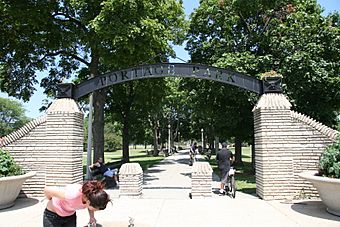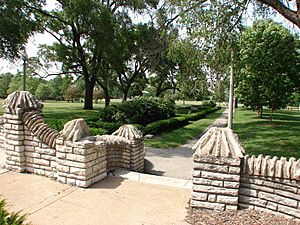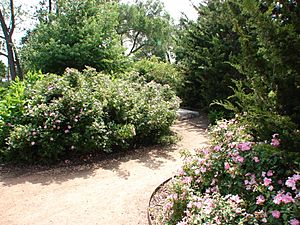Portage Park (Chicago park) facts for kids
Quick facts for kids |
|
|
Portage Park
|
|

Flagstone gate at the southwestern entrance into Portage Park at the intersection of Irving Park Rd. and Central Ave
|
|
| Location | 4100 N. Long Ave., Chicago, Illinois |
|---|---|
| Built | 1913 |
| NRHP reference No. | 95000484 |
| Added to NRHP | 1995 |
Portage Park is a big park in Chicago, Illinois. It covers about 36 acres. You can find it in the Portage Park community area. This park is so important that it's even on the National Register of Historic Places.
The park stretches from Irving Park Road to Berteau Avenue. It's located between Central and Long Avenues. Portage Park is the largest public park on Chicago's Northwest Side. It has many fun things to do. You'll find six tennis courts and two playgrounds. There's also a special area for in-line skating. You can ride bikes on the bike path. There's even a nature walk. For sports lovers, there are five baseball fields. There are also two fields for football or soccer.
Portage Park has two main buildings called fieldhouses. One has a gymnasium. The other is a cultural arts building. The park also has a large Olympic-size pool. It has a big deck for sunbathing. There are also misting sprays. Kids can enjoy an interactive water play area. This area has a slide and diving boards. There's also a smaller heated pool. Soon, a new senior center will be built here. It will be about 6,500 square feet.
Park History
Portage Park gave its name to the whole neighborhood. It helped bring different communities together. The park started in 1913. Local residents formed a group called the Old Portage Park District. The name "Portage" comes from an old route. This route followed what is now Irving Park Road. Native Americans and fur traders used it. They would carry their canoes between the Des Plaines and Chicago Rivers. This act of carrying boats is called "portaging."
The first plan for Portage Park was made by American Park Builders Company. They also built the park between 1913 and 1917. The park's design included a natural swimming lagoon. This lagoon opened in July 1916. A fieldhouse and a gym were added in the 1920s. These were designed by Clarence Hatzfeld. His company designed many bungalows nearby. These homes were in the Prairie Style and Craftsman-style.
Portage Park quickly became the heart of the community. It offered sports and team games. There were also cultural activities and clubs. The park hosted many festivals and special events. These events were for everyone on Chicago's Northwest Side.
The park originally had a pond with a dirt bottom. This pond connected to a concrete pool. The hill you see east of the pool today was made from the dirt. This dirt was removed when the pool was first built.
In 1934, all of Chicago's park groups joined together. They formed the Chicago Park District. This new group got money from the government. This money came from the Works Progress Administration (WPA). The WPA made many improvements at Portage Park. They added more plants and stonework. They also built new fountains and gateways. A comfort station was also added. WPA workers also removed the first swimming lagoon. They built a new kidney-shaped concrete pool.
The WPA also helped build the Rock House. This building was at the south end of Portage Park. It had a small pond with goldfish and flower basins. This goldfish pond was later filled in. This happened because of a polio epidemic in the 1940s. The park was built before any of the surrounding buildings.
In 1959, the park district updated the concrete pool. They built an Olympic-sized pool. This was to get ready for the Pan American Games. In 1972, Portage Park hosted the U.S. Olympic swimming trials. Famous swimmer Mark Spitz set new world records there. In 1998, the swimming pools were updated again. A fun water play area was added for children.






